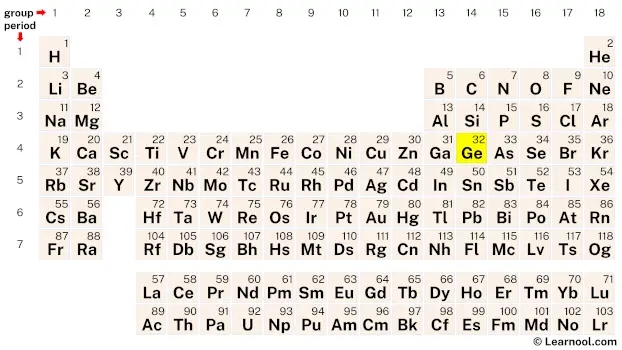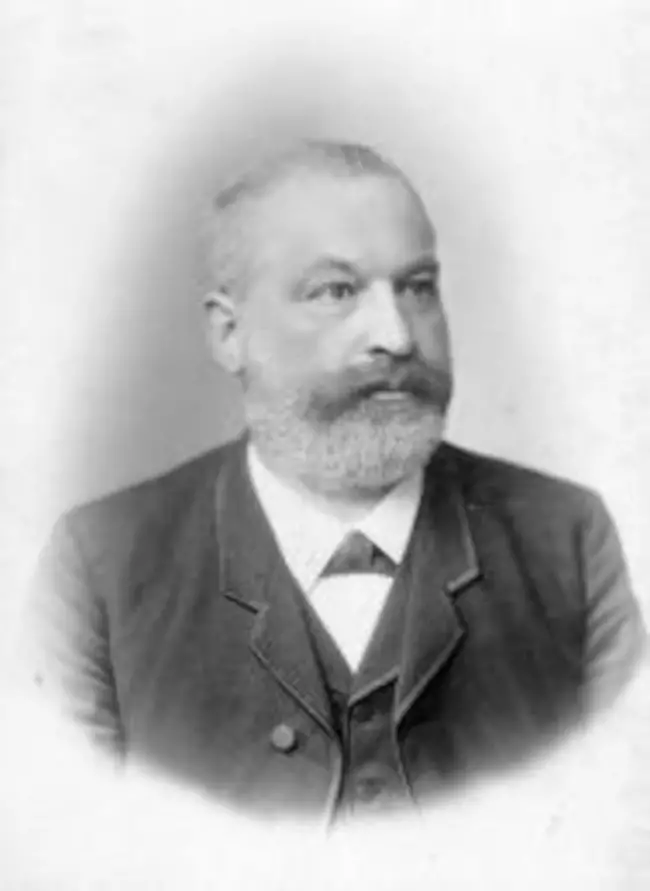
Germanium (Ge) is a chemical element of the periodic table, located in the group 14 and the period 4, and has the atomic number 32. It is a hard, lustrous, grayish-white metalloid, whose name comes from the Latin word “Germania”, which means Germany, homeland of the discoverer. It is a member of the carbon group.
On periodic table
| group | ⇨ | 1 | 2 | 3 | 4 | 5 | 6 | 7 | 8 | 9 | 10 | 11 | 12 | 13 | 14 | 15 | 16 | 17 | 18 |
| period | ⇩ | ||||||||||||||||||
| 1 | 1 H  Hydrogen |
2 He  Helium |
|||||||||||||||||
| 2 | 3 Li  Lithium |
4 Be  Beryllium |
5 B  Boron |
6 C  Carbon |
7 N  Nitrogen |
8 O  Oxygen |
9 F  Fluorine |
10 Ne  Neon |
|||||||||||
| 3 | 11 Na  Sodium |
12 Mg  Magnesium |
13 Al  Aluminium |
14 Si Silicon |
15 P  Phosphorus |
16 S  Sulfur |
17 Cl  Chlorine |
18 Ar  Argon |
|||||||||||
| 4 | 19 K  Potassium |
20 Ca  Calcium |
21 Sc  Scandium |
22 Ti  Titanium |
23 V  Vanadium |
24 Cr  Chromium |
25 Mn  Manganese |
26 Fe  Iron |
27 Co  Cobalt |
28 Ni  Nickel |
29 Cu  Copper |
30 Zn  Zinc |
31 Ga  Gallium |
32 Ge Germanium |
33 As  Arsenic |
34 Se  Selenium |
35 Br  Bromine |
36 Kr  Krypton |
|
| 5 | 37 Rb  Rubidium |
38 Sr  Strontium |
39 Y  Yttrium |
40 Zr  Zirconium |
41 Nb  Niobium |
42 Mo  Molybdenum |
43 Tc  Technetium |
44 Ru  Ruthenium |
45 Rh  Rhodium |
46 Pd  Palladium |
47 Ag  Silver |
48 Cd  Cadmium |
49 In  Indium |
50 Sn  Tin |
51 Sb  Antimony |
52 Te  Tellurium |
53 I  Iodine |
54 Xe  Xenon |
|
| 6 | 55 Cs  Caesium |
56 Ba  Barium |
72 Hf  Hafnium |
73 Ta  Tantalum |
74 W  Tungsten |
75 Re  Rhenium |
76 Os  Osmium |
77 Ir  Iridium |
78 Pt  Platinum |
79 Au  Gold |
80 Hg  Mercury |
81 Tl  Thallium |
82 Pb  Lead |
83 Bi  Bismuth |
84 Po  Polonium |
85 At  Astatine |
86 Rn  Radon |
||
| 7 | 87 Fr  Francium |
88 Ra  Radium |
104 Rf  Rutherfordium |
105 Db  Dubnium |
106 Sg  Seaborgium |
107 Bh  Bohrium |
108 Hs  Hassium |
109 Mt  Meitnerium |
110 Ds  Darmstadtium |
111 Rg  Roentgenium |
112 Cn  Copernicium |
113 Nh  Nihonium |
114 Fl  Flerovium |
115 Mc  Moscovium |
116 Lv  Livermorium |
117 Ts  Tennessine |
118 Og  Oganesson |
||
| 57 La  Lanthanum |
58 Ce  Cerium |
59 Pr  Praseodymium |
60 Nd  Neodymium |
61 Pm  Promethium |
62 Sm  Samarium |
63 Eu  Europium |
64 Gd  Gadolinium |
65 Tb  Terbium |
66 Dy  Dysprosium |
67 Ho  Holmium |
68 Er  Erbium |
69 Tm  Thulium |
70 Yb  Ytterbium |
71 Lu  Lutetium |
|||||
| 89 Ac  Actinium |
90 Th  Thorium |
91 Pa  Protactinium |
92 U  Uranium |
93 Np  Neptunium |
94 Pu  Plutonium |
95 Am  Americium |
96 Cm  Curium |
97 Bk  Berkelium |
98 Cf  Californium |
99 Es  Einsteinium |
100 Fm  Fermium |
101 Md  Mendelevium |
102 No  Nobelium |
103 Lr  Lawrencium |
|||||
| – p block |
Germanium is a p-block element, situated in the fourteenth column and the fourth row of the periodic table. Its atomic number is 32 and its symbol is Ge.
Element information
 |
|
 |
|
| Origin of name | Latin word “Germania” (which means Germany) |
| Symbol | Ge |
| Atomic number (Z) | 32 |
| Atomic mass | 72.64 u |
| Block | p-block |
| Group | 14 (carbon group) |
| Period | 4 |
| Classification | Metalloid |
| Atomic radius | 122 pm |
| Covalent radius | 122 pm |
| Van der Waals radius | 211 pm |
| Melting point | 938.25 ℃, 1720.85 ℉, 1211.40 K |
| Boiling point | 2833 ℃, 5131 ℉, 3106 K |
| Electron configuration | [Ar] 3d10 4s2 4p2 |
| Learn how to write: Germanium electron configuration | |
| Electrons per shell | 2, 8, 18, 4 |
| Learn how to draw: Germanium Bohr model | |
| Crystal structure | Face-centered diamond-cubic |
| Phase at r.t | Solid |
| Density near r.t | 5.323 g/cm3 |
| Main isotopes | Germanium-70, Germanium-72, Germanium-73, Germanium-74 |
| Natural occurrence | Primordial |
| Oxidation state | -4, +2, +4 |
| Electronegativity (Pauling scale) | 2.01 |
| Protons Neutrons Electrons |
32 41 32 |
| Learn how to find: Germanium protons neutrons electrons | |
| Valence electrons | 4 |
| Learn how to find: Germanium valence electrons | |
| CAS number | 7440-56-4 |
| Discovered by | Clemens Winkler in 1886 |
History

Germanium was first predicted by the Russian chemist Dmitri Mendeleev in 1869. He named it eka-silicon and predicted its properties based on its position in the periodic table. In 1886, Clemens Winkler, a German chemist, discovered germanium while analyzing a sample of the mineral argyrodite. Winkler isolated the element by repeatedly extracting it with acid and then precipitating it with hydrogen sulfide.
In the early 1900s, germanium was primarily used in research laboratories, but its use expanded during World War Ⅱ. It was used as a semiconductor in early transistors and as a material for rectifiers and diodes in electronic applications. Germanium was a key component in the development of radar and other military technologies during the war.
In the post-war period, germanium continued to be used in electronics, but its use declined with the development of silicon-based semiconductors. Today, germanium is primarily used as a substrate material in the production of infrared optical devices, such as lenses and prisms. It is also used as a dopant in the production of some types of transistors and diodes.
Occurrence and production
Germanium is a rare element, and it is not found in its pure form in nature. It mainly occurs in minerals such as germanite, argyrodite, and zinc ores. Germanium is also present in coal deposits, and the ash produced from burning coal is a major source of germanium. Additionally, it is found in some copper, lead, and silver ores.
The production of germanium involves several steps. Initially, it is extracted from the ore using a combination of crushing, grinding, and flotation processes. Once the germanium-containing concentrate is obtained, it is further processed through a series of steps to purify the germanium.
The purification process involves the use of multiple techniques, including distillation, zone refining, and fractional crystallization. The final product is typically a high-purity germanium ingot, which can be further processed into various forms such as powder, pellets, or sputtering targets. Germanium is also produced as a by-product of zinc and copper smelting, and its recovery from these sources is an important secondary source of germanium production.
Properties
Germanium is a hard, lustrous, grayish-white metalloid in the carbon group, chemically similar to its group neighbors tin and silicon.
Germanium is a semiconductor, with an electrical conductivity between that of a metal and an insulator. Its conductivity increases slightly with increased temperature.
It has a diamond-like crystal structure and is brittle and easily fractured.
Germanium is stable in air and water but reacts with concentrated nitric acid and hot concentrated sulfuric acid.
It has a relatively high density of 5.323 g/cm3 and a melting point of 938.25 ℃.
Germanium has four valence electrons in its outermost shell, making it an important material for use in transistors, solar cells, and other electronic applications.
It is also used in the production of alloys, as a catalyst in some chemical reactions, and in some medical imaging techniques.
Applications
Germanium is an important material used in the production of semiconductors, particularly in the manufacturing of transistors, diodes, and other electronic devices.
Germanium is used as a dopant in the production of optical fibers, which are used in telecommunications and other applications that require the transmission of data over long distances.
Germanium is also used as a material for making lenses and windows in infrared systems.
Germanium is used in the production of some types of solar cells.
Germanium compounds are used as catalysts in the production of certain polymers.
Germanium is used as a detector material for gamma radiation in the nuclear industry.
Germanium is used as an alloying agent with other metals, such as iron and copper, to improve their properties.
Some germanium compounds are used as flame retardants in the manufacturing of plastics and other materials.
Interesting facts
Germanium was predicted by Dmitri Mendeleev in his 1869 periodic table before its discovery in 1886 by Clemens Winkler.
Germanium is a semiconductor, which means it can conduct electricity under certain conditions. It has been used in the development of transistors and other electronic devices.
Germanium is named after Germany, where it was first discovered. However, it was also independently discovered in the United States around the same time.
Germanium is a relatively rare element, making up only about 1.6 parts per million of the Earth’s crust.
Germanium has some interesting optical properties, including the ability to transmit infrared light while blocking visible light. This makes it useful in optical applications such as lenses and filters.
Germanium is a brittle and hard material, with a Mohs hardness of around 6. It has a high melting point of 938.25 ℃ and a boiling point of 2833 ℃.
Germanium has some potential medical applications, including as a contrast agent in imaging and as a possible cancer treatment.
Germanium is used in some types of solar cells, as well as in some types of thermoelectric devices for converting heat into electricity.
Related
More elements
External links
- https://www.rsc.org/periodic-table/element/32/germanium
- https://en.wikipedia.org/wiki/Germanium
- https://www.britannica.com/science/germanium
- https://pubchem.ncbi.nlm.nih.gov/element/Germanium
- https://chemistrytalk.org/germanium-element/
- https://education.jlab.org/itselemental/ele032.html
- https://www.chemicool.com/elements/germanium.html
- https://www.ducksters.com/science/chemistry/germanium.php
Deep
Learnool.com was founded by Deep Rana, who is a mechanical engineer by profession and a blogger by passion. He has a good conceptual knowledge on different educational topics and he provides the same on this website. He loves to learn something new everyday and believes that the best utilization of free time is developing a new skill.
